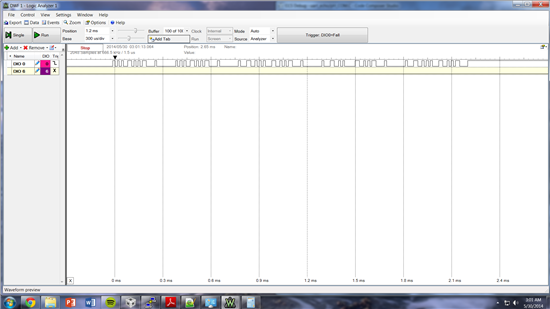I am trying to communicate with a sensor via UART (UART1_BASE) while also communicating with a terminal (UART0_BASE). I have attached the communication portion of my program and it is currently set to only one UART at a time. When I select UART0 I have no problem transmitting all of the strings to the terminal, however I only get a set amount (with no delays I get 5 writes) when I use UART1 (Seen on oscilloscope). I change UART by switching commented portions of code and replace UARTX with correct number.
Please help!
/*
* pH_Control.c
*
* Created on: May 29, 2014
* Author: Jordan
*/
#include <stdio.h>
#include <math.h>
#include <string.h>
#include <stdlib.h>
#include <stdint.h>
#include <stdbool.h>
#include "inc/hw_ints.h"
#include "inc/hw_memmap.h"
#include "driverlib/debug.h"
#include "driverlib/fpu.h"
#include "driverlib/gpio.h"
#include "driverlib/interrupt.h"
#include "driverlib/pin_map.h"
#include "driverlib/rom.h"
#include "driverlib/sysctl.h"
#include "driverlib/uart.h"
#include "Setup.h" /* Includes strings to be sent to stamp
* Commands include: set_(4,7,10), reset,
* info, led_(on,off)
*/
// Commands:
void UART_write (uint32_t ui32Base);
void init_TM4C (void);
// Variables:
char pH_out[20]; // char array used to hold outgoing pH data
int main(void)
{
//Initialize Microcontroller
init_TM4C();
//Initialize Port to write to sensor
ROM_UARTCharPutNonBlocking(UART1_BASE, '5');
while(1)
{
//
// Blink the LED to show a character transfer is occurring.
//
GPIOPinWrite(GPIO_PORTF_BASE, GPIO_PIN_2, GPIO_PIN_2);
//
// Delay for 1 millisecond. Each SysCtlDelay is about 3 clocks.
//
SysCtlDelay(SysCtlClockGet() / (1 * 3));
//
// Turn off the LED
//
GPIOPinWrite(GPIO_PORTF_BASE, GPIO_PIN_2, 0);
}
}
void init_TM4C (void)
{
//
// Enable lazy stacking for interrupt handlers. This allows floating-point
// instructions to be used within interrupt handlers, but at the expense of
// extra stack usage.
//
ROM_FPUEnable();
ROM_FPULazyStackingEnable();
//
// Set the clocking to run directly from the crystal.
//
ROM_SysCtlClockSet(SYSCTL_SYSDIV_1 | SYSCTL_USE_OSC | SYSCTL_OSC_MAIN |
SYSCTL_XTAL_16MHZ);
//
// Enable the GPIO port that is used for the on-board LED.
//
ROM_SysCtlPeripheralEnable(SYSCTL_PERIPH_GPIOF);
//
// Enable the GPIO pins for the LED (PF2).
//
ROM_GPIOPinTypeGPIOOutput(GPIO_PORTF_BASE, GPIO_PIN_2);
//
// Enable the peripherals used by this example.
//
ROM_SysCtlPeripheralEnable(SYSCTL_PERIPH_UART1);
ROM_SysCtlPeripheralEnable(SYSCTL_PERIPH_GPIOC);
//
// Enable processor interrupts.
//
ROM_IntMasterEnable();
//
// Set GPIO A0 and A1 as UART pins.
//
GPIOPinConfigure(GPIO_PC4_U1RX);
GPIOPinConfigure(GPIO_PC5_U1TX);
ROM_GPIOPinTypeUART(GPIO_PORTC_BASE, GPIO_PIN_4 | GPIO_PIN_5);
//
// Configure the UART for 115,200, 8-N-1 operation.
//
ROM_UARTConfigSetExpClk(UART1_BASE, ROM_SysCtlClockGet(), 115200,
(UART_CONFIG_WLEN_8 | UART_CONFIG_STOP_ONE |
UART_CONFIG_PAR_NONE));
//
// Enable the UART interrupt.
//
ROM_IntEnable(INT_UART1);
ROM_UARTIntEnable(UART1_BASE, UART_INT_RX | UART_INT_RT);
}
// Write relevant string to given base
void UART_write (uint32_t ui32Base)
{
// init_base1();
b = sizeof(pH_out);
for (a = 0; a < b; a++)
{
ROM_UARTCharPutNonBlocking(ui32Base, pH_out[a]);
//
// Blink the LED to show a character transfer is occuring.
//
GPIOPinWrite(GPIO_PORTF_BASE, GPIO_PIN_2, GPIO_PIN_2);
//
// Delay for 1 millisecond. Each SysCtlDelay is about 3 clocks.
//
SysCtlDelay(SysCtlClockGet() / (1000 * 3));
//
// Turn off the LED
//
GPIOPinWrite(GPIO_PORTF_BASE, GPIO_PIN_2, 0);
}
SysCtlDelay(SysCtlClockGet() / (1));
}
/* * Setup.h * * Created on: May 27, 2014 * Author: Jordan */ #ifndef SETUP_H_ #define SETUP_H_ //*********************************************************************************************// // Internal Strings: //*********************************************************************************************// //*********************************************************************************************// // Stamp Commands: //*********************************************************************************************// //Universal Commands: char reset[20] = "X\r"; // Command to reset the device to factoy default mode (R) char read_cont[20] = "c\r"; // Command to put stamp in continuous reading mode (C) char cont_esc[20] = "e\r"; // Command to take stamp out of continuous mode (E) char read_one[20] = "R\r"; // Command to put stamp in single-read mode (S) char info[20] = "I\r"; // Command to query the information (Q) char led_off[20] = "L0\r"; // Command to turn leds OFF (0) char led_on[20] = "L1\r"; // Command to turn leds ON (L) //pH Commands: char set_4[20] = "f\r"; // Command to calibrate to a pH of 4.00 (1) char set_7[20] = "s\r"; // Command to calibrate to a pH of 7.00 (2) char set_10[20] = "t\r"; // Command to calibrate to a pH of 10.00 (3) #endif /* SETUP_H_ */


